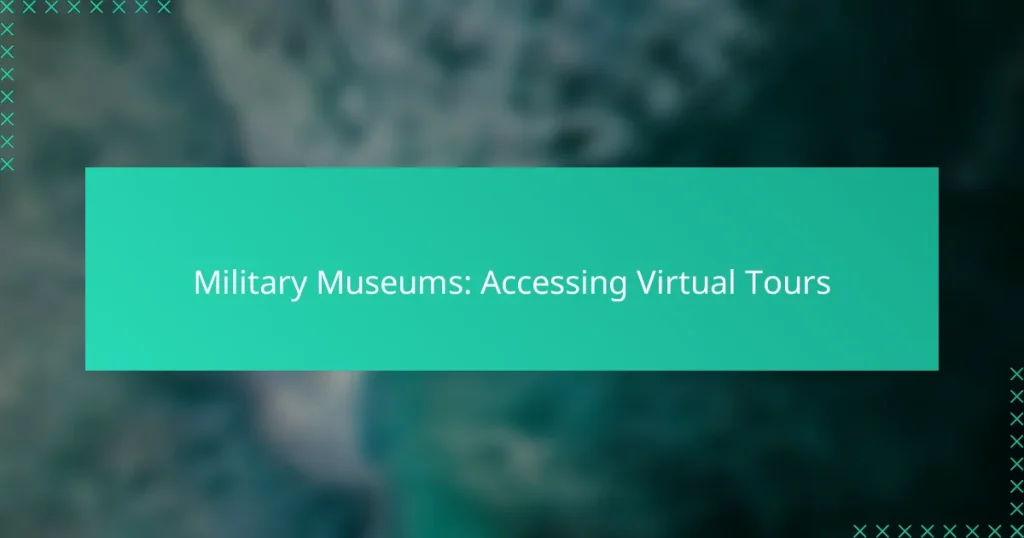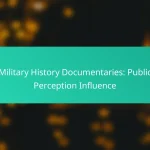Virtual tours of military museums provide an accessible way to explore significant exhibits and artifacts from the comfort of your home. Many museums in the US and around the world offer free online experiences, enhancing learning opportunities and making military history more reachable for diverse audiences. Notable institutions like the Imperial War Museum and the Canadian War Museum present unique virtual experiences that allow visitors to engage with their collections from anywhere.
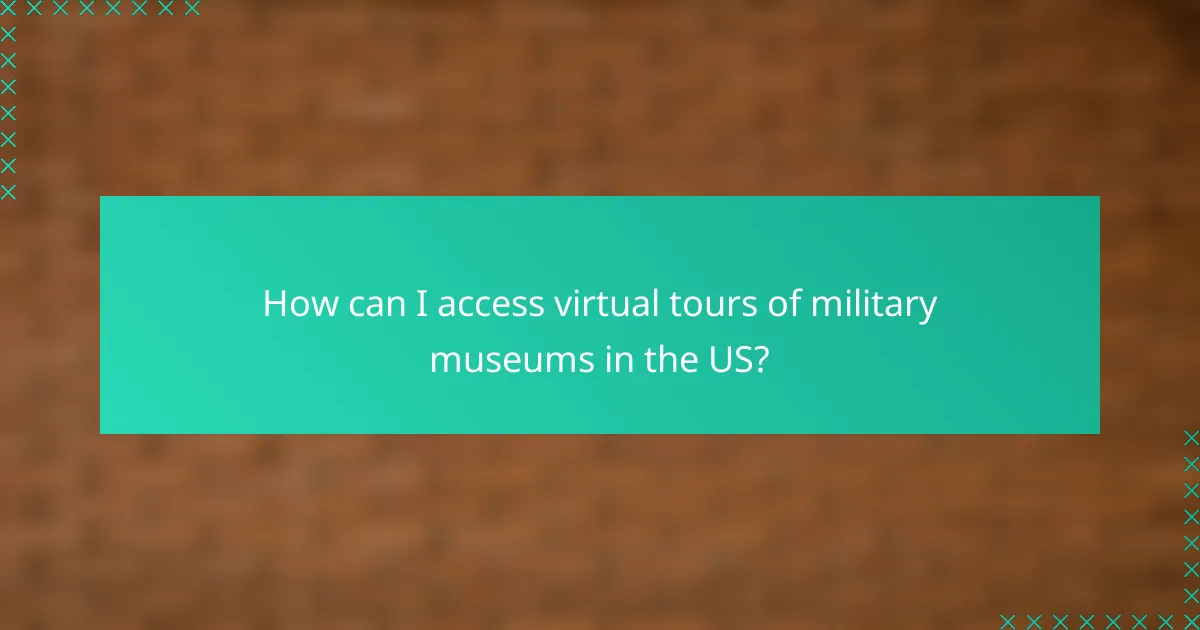
How can I access virtual tours of military museums in the US?
You can access virtual tours of military museums in the US through their official websites or dedicated platforms that host these experiences. Many museums offer free online tours that allow you to explore exhibits and artifacts from the comfort of your home.
National WWII Museum virtual tour
The National WWII Museum in New Orleans provides an engaging virtual tour that showcases its extensive collection of artifacts and exhibits. Visitors can navigate through various galleries, including immersive experiences that highlight key events and personal stories from the war.
To access the virtual tour, simply visit the museum’s official website. The tour is user-friendly and allows you to explore at your own pace, making it a great educational resource for all ages.
Smithsonian National Air and Space Museum virtual tour
The Smithsonian National Air and Space Museum offers a comprehensive virtual tour featuring its iconic aircraft and space artifacts. This online experience includes interactive elements that allow users to learn about the history and technology behind aviation and space exploration.
You can access the virtual tour through the Smithsonian’s website, where you’ll find various educational resources and multimedia content that enhance your understanding of aerospace history.
American Revolution Museum at Yorktown virtual tour
The American Revolution Museum at Yorktown provides a virtual tour that explores the Revolutionary War’s impact on American history. This tour includes detailed exhibits, reenactments, and artifacts that bring the era to life.
To participate, visit the museum’s website, where you can engage with interactive features and educational materials tailored for both students and history enthusiasts. This virtual experience is a valuable way to connect with America’s past.
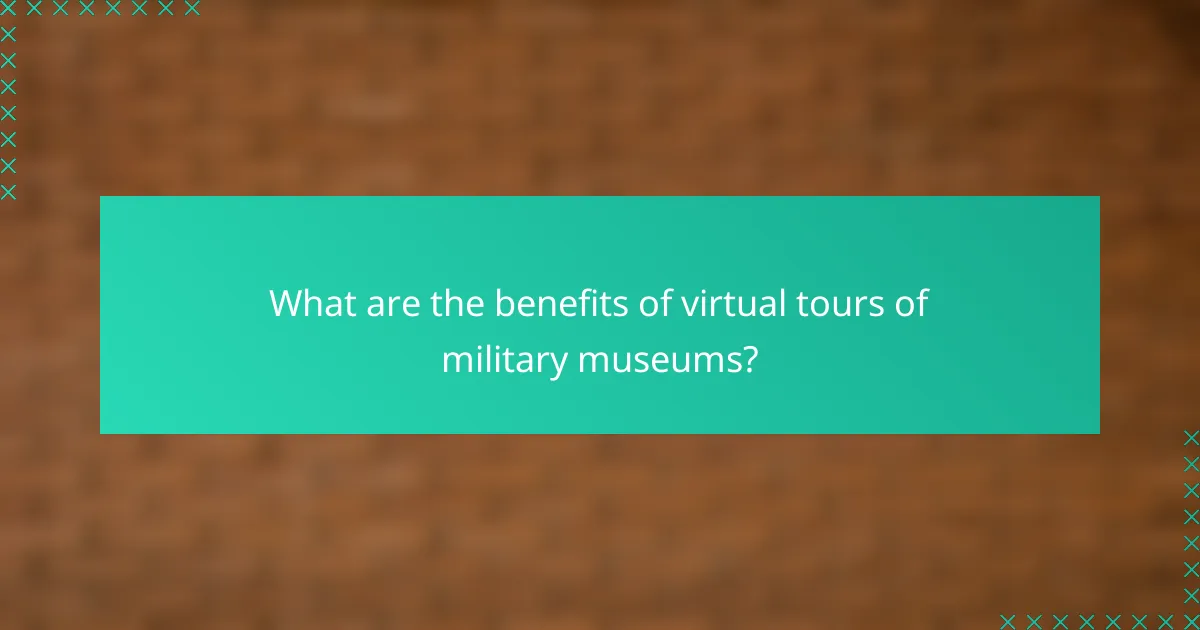
What are the benefits of virtual tours of military museums?
Virtual tours of military museums offer numerous advantages, including increased accessibility, enhanced learning opportunities, and cost savings. These tours allow individuals to explore exhibits from anywhere, making military history more reachable for diverse audiences.
Accessibility for remote visitors
Virtual tours provide access to military museums for those who may not be able to visit in person due to geographical, physical, or financial constraints. This means that individuals from remote areas or those with mobility challenges can engage with military history without the need for travel.
Many museums have optimized their virtual experiences to be user-friendly, often requiring only a stable internet connection and a device. This accessibility broadens the audience and encourages a wider appreciation of military heritage.
Interactive learning experiences
Virtual tours often feature interactive elements such as 360-degree views, video content, and quizzes that enhance the learning experience. These features allow visitors to engage with the material actively rather than passively observing.
For example, some tours include clickable artifacts that provide detailed information, making it easier for users to dive deeper into specific topics of interest. This interactive approach caters to various learning styles, making military history more engaging.
Cost-effective exploration
Participating in virtual tours of military museums can be significantly more affordable than visiting in person. There are typically no travel expenses, and many virtual tours are offered free of charge or at a low cost compared to admission fees for physical visits.
This cost-effectiveness allows individuals and families to explore multiple museums without financial strain, making it feasible to learn about different military histories and cultures from the comfort of home.
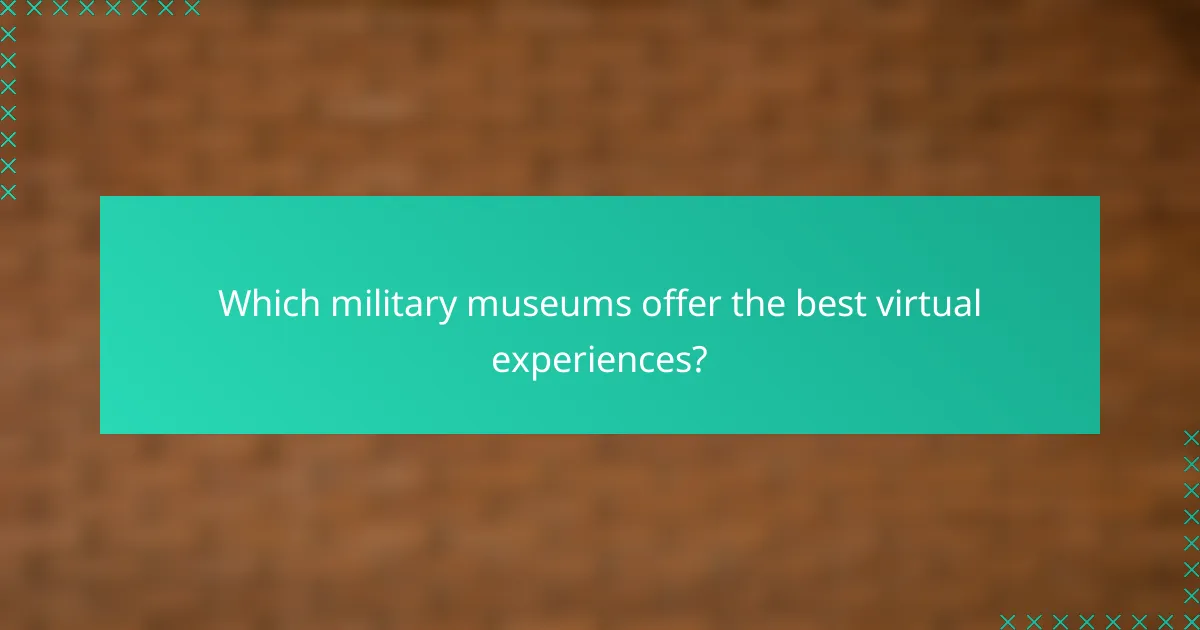
Which military museums offer the best virtual experiences?
Several military museums provide exceptional virtual experiences, allowing visitors to explore their collections and exhibits from anywhere. Notable options include the Imperial War Museum, Canadian War Museum, and Australian War Memorial, each offering unique online tours and resources.
Imperial War Museum virtual experience
The Imperial War Museum (IWM) offers a rich virtual experience that includes interactive exhibits, video content, and detailed narratives about military history. Users can explore various themes such as World War I, World War II, and contemporary conflicts through engaging multimedia presentations.
To access the virtual experience, visit the IWM website where you can navigate through different exhibits and collections. It’s advisable to check for any scheduled live events or guided tours that may enhance your experience.
Canadian War Museum online tours
The Canadian War Museum provides online tours that showcase its extensive collection of military artifacts, documents, and personal stories. These tours are designed to educate visitors about Canada’s military history and the experiences of those who served.
Visitors can access the online tours through the museum’s official website, where they can choose from various thematic tours. It’s beneficial to explore the educational resources available, including lesson plans and activities for students and educators.
Australian War Memorial virtual exhibits
The Australian War Memorial offers virtual exhibits that highlight significant events and contributions of Australian forces in various conflicts. These exhibits include photographs, personal accounts, and artifacts that bring history to life.
To experience these virtual exhibits, navigate to the Australian War Memorial’s website. Look for interactive features that allow you to delve deeper into specific topics, and consider participating in any online discussions or webinars that may be available.
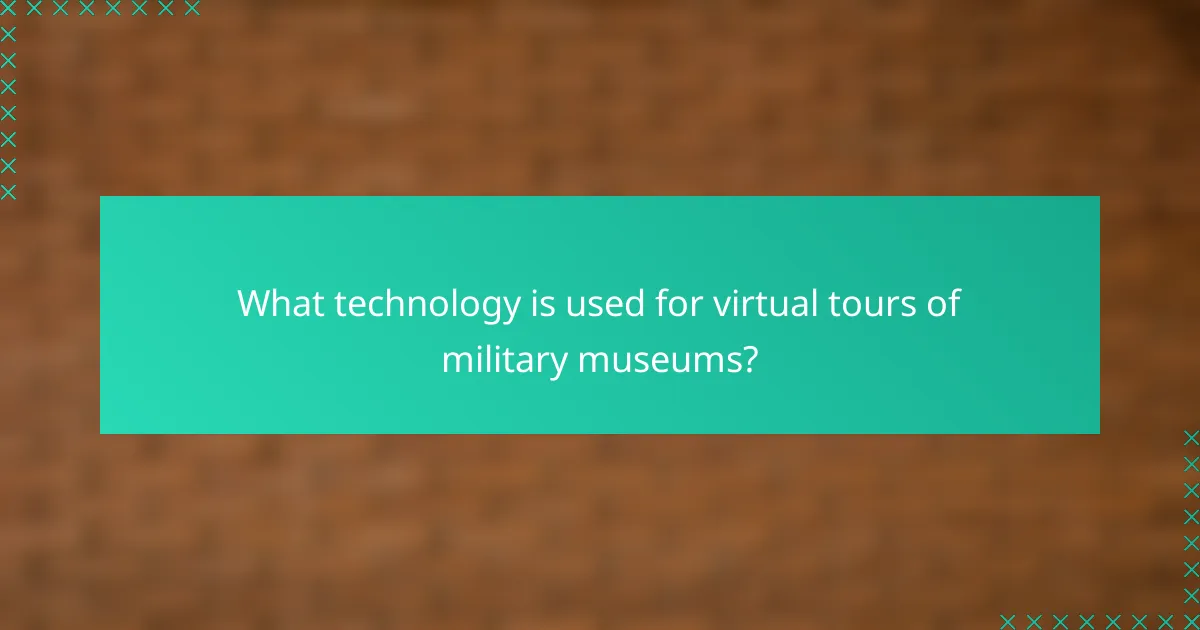
What technology is used for virtual tours of military museums?
Virtual tours of military museums utilize various technologies to create immersive experiences. The most common methods include 360-degree video, augmented reality applications, and virtual reality headsets, each offering unique ways to explore exhibits from anywhere.
360-degree video technology
360-degree video technology captures a full panoramic view of a museum space, allowing users to navigate through the environment. This technology typically requires a special camera setup that records in all directions, providing a realistic experience of being in the museum.
Users can interact with the video by clicking on hotspots that reveal additional information, images, or videos about specific exhibits. This method is accessible on most devices, including smartphones and computers, making it a popular choice for virtual tours.
Augmented reality applications
Augmented reality (AR) applications enhance the real-world environment by overlaying digital information onto physical objects. In military museums, AR can provide interactive elements, such as historical context or 3D models of artifacts when viewed through a smartphone or tablet.
These applications often require specific markers or QR codes placed around the museum to trigger the AR content. This technology can engage visitors more deeply by allowing them to visualize historical events or interact with exhibits in a dynamic way.
Virtual reality headsets
Virtual reality (VR) headsets offer a fully immersive experience by simulating a three-dimensional environment. Users wear headsets that block out the real world, transporting them into a virtual military museum where they can explore exhibits as if they were physically present.
VR experiences often include guided tours, interactive displays, and the ability to manipulate objects within the virtual space. While this technology can provide a rich experience, it typically requires more advanced equipment and may not be as widely accessible as 360-degree video or AR applications.
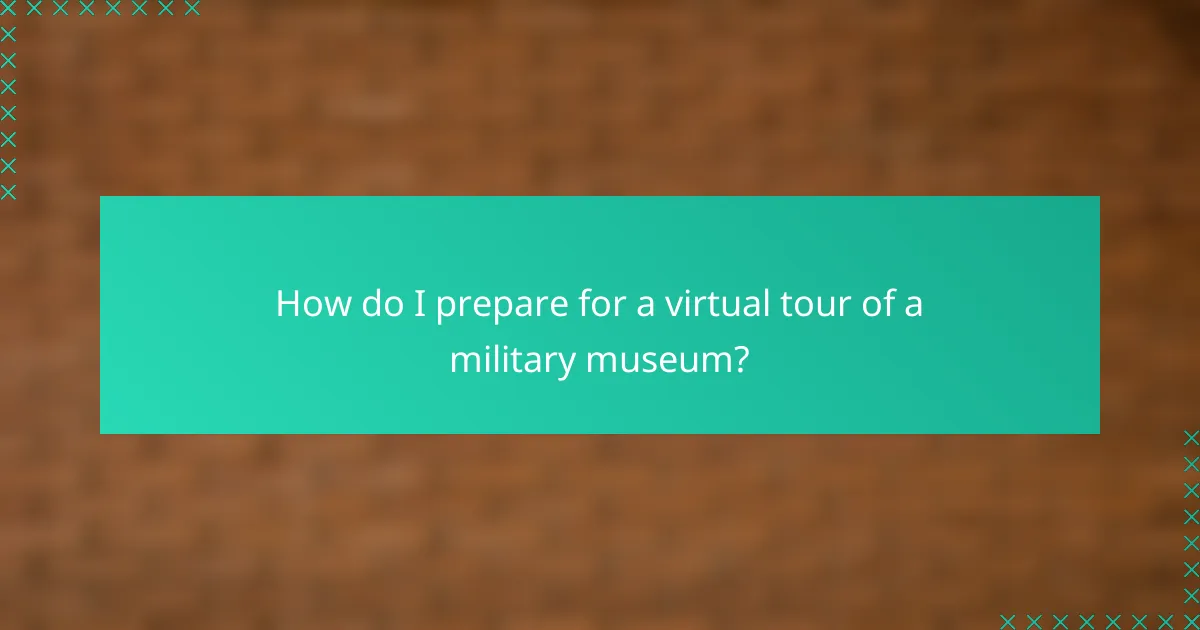
How do I prepare for a virtual tour of a military museum?
Preparing for a virtual tour of a military museum involves ensuring you have the right technology, scheduling your viewing time effectively, and gathering any additional materials that can enhance your experience. By taking these steps, you can maximize your engagement and understanding of the exhibits.
Check technical requirements
Before starting a virtual tour, verify that your device meets the necessary technical specifications. Most tours require a stable internet connection, ideally with speeds of at least 5 Mbps, and a compatible web browser, such as Chrome or Firefox.
Additionally, ensure that your device has updated software and sufficient battery life. Some tours may also offer enhanced experiences through virtual reality (VR), which would require specific hardware and applications.
Plan your viewing schedule
Scheduling your virtual tour is crucial for an optimal experience. Consider the time of day when you are most alert and free from distractions. Many military museums offer tours that can last anywhere from 30 minutes to over an hour, so allocate enough time to fully engage with the content.
Check the museum’s website for specific tour times and any live elements, such as guided sessions or Q&A opportunities. If available, mark these on your calendar to ensure you don’t miss out.
Gather supplementary materials
To enhance your virtual tour experience, gather supplementary materials such as books, articles, or documentaries related to the exhibits you will be viewing. This background knowledge can provide context and deepen your understanding of the artifacts and their historical significance.
Some museums may also provide downloadable resources or suggested reading lists on their websites. Having these materials ready can make your virtual tour more enriching and informative.
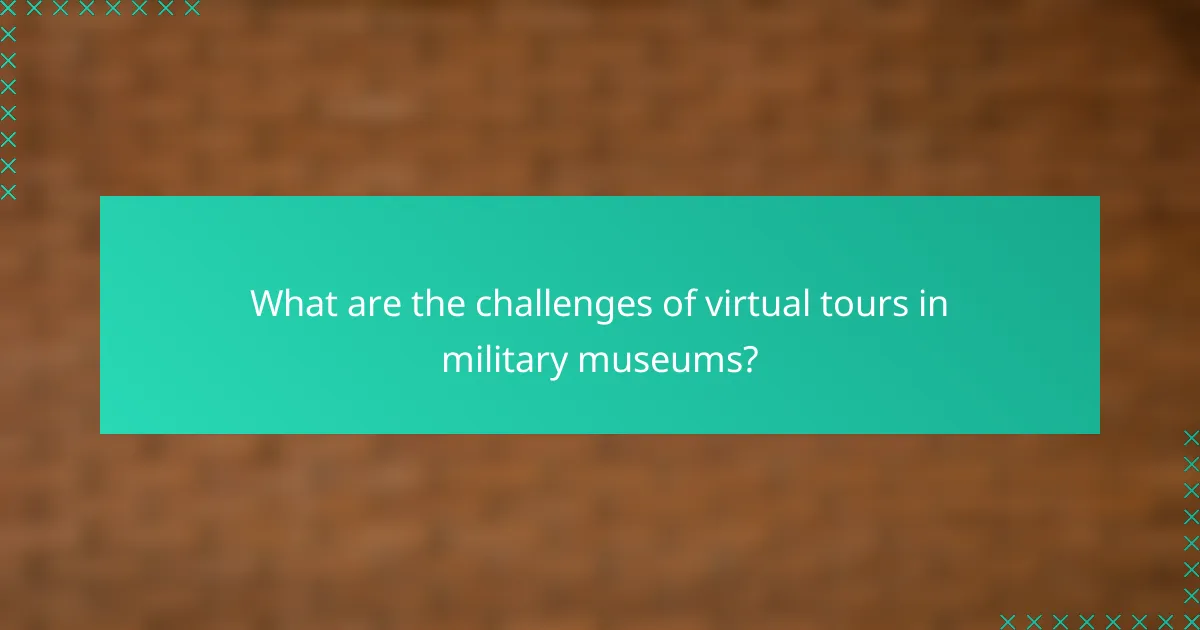
What are the challenges of virtual tours in military museums?
Virtual tours in military museums face several challenges that can affect user experience. These include limited interactivity, potential technical issues, and a less immersive experience compared to physical visits.
Limited interactivity compared to physical visits
Virtual tours often lack the hands-on engagement that physical visits provide. While users can navigate through exhibits, they may miss out on tactile experiences, such as handling artifacts or participating in live demonstrations.
Many virtual platforms offer basic navigation tools, but they may not allow for deeper exploration or interaction with exhibits. This limits the ability to ask questions or engage with knowledgeable staff, which is a significant part of the museum experience.
Potential technical issues
Technical problems can hinder the effectiveness of virtual tours. Users may encounter issues such as slow loading times, compatibility problems with devices, or software glitches that disrupt the experience.
To mitigate these issues, users should ensure they have a stable internet connection and use updated browsers. Museums can also provide technical support or FAQs to assist visitors in troubleshooting common problems.
Less immersive experience
Virtual tours generally offer a less immersive experience than in-person visits. The absence of physical presence can diminish the emotional impact of historical artifacts and exhibits, which are often best appreciated in their actual context.
While some virtual tours use advanced technologies like 360-degree views or augmented reality, they still cannot replicate the atmosphere and sensory experiences of being in a military museum. Visitors should manage their expectations and consider these limitations when opting for virtual tours.
